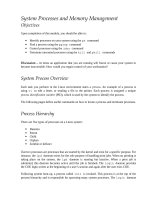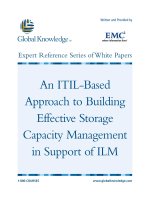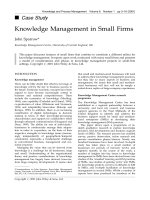Memory management in c
Bạn đang xem bản rút gọn của tài liệu. Xem và tải ngay bản đầy đủ của tài liệu tại đây (415.49 KB, 29 trang )
Advanced C Programming
Memory Management II
(malloc, free, alloca, obstacks, garbage collection)
Sebastian Hack
Christoph Weidenbach
16.12.2008
computer science
saarland
university
1
Contents
Memory Allocation
alloca / Variable length arrays
malloc and free
Memory Allocation in UNIX
The Doug Lea Allocator
Binning
allocate
free
Chunk Coalescing
Region-based memory management
Obstacks
Garbage Collection in C
A Critique of Custom Memory Allocation
Bibliography
2
Problems of Memory Allocation
Fragmentation
Not being able to reuse free memory
Free memory is split up in many small pieces
Cannot reuse them for large-piece requests
Primary objective of today’s allocators is to avoid fragmentation
Locality
Temporal and spacial locality go along with each other
Memory accesses near in time are also near in space
Try to serve timely near requests with memory in the same region
☞ Less paging
Memory allocation locality not that important for associative caches
☞ Enabling locality by the programmer more important
3
Practical Considerations (see [Lea])
A good memory allocator needs to balance a number of goals:
Minimizing Space
The allocator should not waste space
Obtain as little memory from the system as possible
Minimize fragmentation
Minimizing Time
malloc, free and realloc should be as fast as
possible in the average case
Maximizing Tunability
Configure optional features
(statistics info, debugging, . . . )
Maximizing Locality
Allocate chunks of memory that are typically used
together near each other
Helps minimize page and cache misses during
program execution
Minimizing Anomalies
Perform well across wide range of real loads
4
Approaches
Allocate and Free
Allocating and freeing done by the programmer
Bug-prone: Can access memory after being freed
Potentially efficient: Programmer should know when to free what
Garbage Collection
User allocates
System automatically frees dead chunks
Less bug-prone
Potentially inefficient:
Overhead of the collection, many dead chunks
Region-based approaches
User allocates chunks inside a region
Only the region can be freed
Efficiency of allocate and free
Slightly less bug-prone
many dead chunks
5
Allocation on the stack
If you know that the allocated memory will be only used during life
time of a function
Allocate the memory in the stack frame of the function
Allocation costs only increment of stack pointer
Freeing is “free” because stack pointer is restored at function exit
Don’t do it for recursive functions (stack might grow too large)
void foo ( int n) {
int * arr = allo ca ( n * sizeo f (* arr ));
}
Only do this if you do not statically know the size of the memory to
allocate
alloca is strongly machine and compiler dependent and not POSIX!
☞ Only use if absolutely necessary
In C99, use VLAs instead (unfortunately not in C++)
6
Malloc and free
In every execution of the program, all allocated memory should be freed
Make it proper ☞ make it more bug-free
Never waste if you don’t need to
You might make a library out of your program
People using that library will assume proper memory management
Purpose of malloc, free
Get memory for the process from OS (mmap, sbrk, . . . )
Manage freed memory for re-utilization
7
Getting Memory from the OS (UNIX)
Unices usually provide two syscalls to enlarge the memory of a process:
brk
Move the end of the uninitialized data segment
At the start of the program, the break is directly behind the
uninitialized data segment of the loaded binary
Moving the break adds memory to the process
malloc has to set the break as tightly as possible
☞ deal with fragmentation
Reuse unused memory below the break
brk is fast
mmap
Map in pages into a process’ address space
Finest granularity: size of a page (usually 4K)
More overhead in the kernel than brk
Used by malloc only for large requests (> 1M)
☞ Reduces fragmentation: pages can be released independently from
each other
8
Contents
Memory Allocation
alloca / Variable length arrays
malloc and free
Memory Allocation in UNIX
The Doug Lea Allocator
Binning
allocate
free
Chunk Coalescing
Region-based memory management
Obstacks
Garbage Collection in C
A Critique of Custom Memory Allocation
Bibliography
9
The Doug Lea Allocator (DL malloc)
Base of glibc malloc
One of the most efficient allocators
Very fast due to tuned implementation
Uses a best-fit strategy:
☞ Re-use the free chunk with the smallest waste
Coalesces chunks upon free
☞ Reduce fragmentation
Uses binning to find free chunks fast
Smallest allocatable chunk:
32-bit system: 8 bytes + 8 bytes bookkeeping
64-bit system: 16 bytes + 16 bytes bookkeeping
10
Binning
Goal: Find the best-fitting free chunk fast
Solution: Keep bins of free-lists/trees
Requests for small memory occur often
Split bins into two parts
32 exact-size bins for everything up to 256 bytes
32 logarithmic scaled bins up to 2
pointer size
16 24
· · ·
248 256 384
· · ·
8M Rest
32 fixed-size bins 32 variable-size bins
free-list
11
Searching the best-fitting Chunk
Small Requests < 256 bytes
Check if there is a free chunk in the corresponding exact-size bin
If not, look into the next larger exact-size bin and check there
If that bin had no chunk too, check the designated victim (dv) chunk
If the dv chunk was not sufficiently large
search the smallest available small-size chunk
split off a chunk of needed size
make the rest the designated victim chunk
If no suitable small-size chunk was found
split off a piece of a large-size chunk
make the remainder the new dv chunk
Else, get memory from the system
Remark
Using the dv chunk provides some locality as unserved requests get
memory next to each other
12
Searching the best-fitting Chunk
Large Requests ≥ 256 bytes
Non-exact bins organize the chunks as binary search trees
Two equally spaced bins for each power of two
Every tree node holds a list of chunks of the same size
Tree is traversed by inspecting the bits in size
(from more significant to less significant)
Everything above 12M goes into the last bin (usually very rare)
16 24
· · ·
248 256 384
· · ·
Rest
32 fixed-size bins 32 variable-size bins
8M
8M–10M
8M–9M 9M–10M
10M–12M
free-list
13
What happens on a free?
Coalesce chunk to free with surrounding free chunks
Treat special cases if one of the surrounding chunks is dv, mmap’ed,
the wilderness chunk
Reinsert the (potentially coalesced) chunk into the free list/tree of
the according bin
Coalescing very fast due to “boundary tag trick”:
Put the size of a free chunk its beginning and its end
14
Chunk Coalescing
If a chunk is freed it is immediately coalesced with free blocks
around it (if there are any)
Free blocks are always as large as possible
Avoid fragmentation
Faster lookup because there are fewer blocks
Invariant: The surrounding chunks of a chunk are always occupied
15
Contents
Memory Allocation
alloca / Variable length arrays
malloc and free
Memory Allocation in UNIX
The Doug Lea Allocator
Binning
allocate
free
Chunk Coalescing
Region-based memory management
Obstacks
Garbage Collection in C
A Critique of Custom Memory Allocation
Bibliography
16
Region-based Memory Allocation
Get a large chunk of memory
Allocate small pieces out of it
Can free only the whole region
Not particular pieces within the region
Advantages:
Fast allocation/de-allocation possible
Engineering
Can free many things at once
Very good for phase-local data
(data that is only used in a certain phase in the program)
Think about large data structures: graphs, trees, etc.
Do not need to traverse to free each node
Disadvantages:
Potential large waste of memory
17
Obstacks (Object Stacks)
Introduction
Region-based memory allocation in the GNU C library
Memory is organized as a stack:
Allocation/freeing sets the stack mark
Cannot free single chunks inside the stack
Can be used to “grow” an object:
Size of the object is not yet known at allocation site
Works on top of malloc
18
Allocation/Deallocation
void test ( int n) {
struct obst a ck obst ;
obs tac k_i ni t (& obst );
/* Alloc ate memory for a s tring of lengt h n -1 */
char *str = ob st ack _al lo c (& obst , n * siz eof ( str [0] ) );
/* Alloc ate an array for n node s */
node_t ** node s = o bs tac k_a llo c (& obst , n * si zeof (nodes [0]));
/* Store the curre nt mark of the o bsta ck */
void *mark = obst ack _ba se (& obst );
/* Alloc ate the node s */
for ( i = 0; i < n; i ++)
nodes [i ] = ob s ta ck_ all oc (& obst , siz eof (node [0 ]));
/* All the marks are gone */
obs tac k_f re e (& obst , mark );
/* Ever yth ing has gone */
obs tac k_f re e (& obst , NULL );
}
19
Growing an obstack
Sometimes you do not know the size of the data in advance
(e.g. reading from a file)
Usually, you to realloc and copy
obstacks do that for you
Cannot reference data in growing object while growing
addresses might change because grow might copy the chunk
Call obstack finish when you finished growing
Get a pointer to the grown object back
int * re ad_ int s ( struct obsta ck *obst , FILE *f ) {
while (! feof (f)) {
int x , res ;
res = fscan f (f , "%d " , &x );
if ( res == 1)
obs ta ck _ in t_ gro w (obst , x );
else
break ;
}
return ob sta ck _ fi nis h (obst );
}
20
Contents
Memory Allocation
alloca / Variable length arrays
malloc and free
Memory Allocation in UNIX
The Doug Lea Allocator
Binning
allocate
free
Chunk Coalescing
Region-based memory management
Obstacks
Garbage Collection in C
A Critique of Custom Memory Allocation
Bibliography
21
Garbage Collection
Garbage collection is the automatic reclamation of memory that is
no longer in use
“Write mallocs without frees”
Basic principle:
At each moment we have a set of roots into the heap:
pointers in registers, on the stack, in global variables
These point to objects in the heap
which in turn point to other objects
All objects and pointers form a graph
Perform a search on the graph starting from the roots
All non-reachable objects can no longer be referenced
Their memory can thus be reclaimed
Major problems for C/C++:
Get all the roots
Determine if a word is a pointer to allocated memory
22
The Boehm-Demers-Weiser Collector [Boehm]
Compiler-independent implementation of a C/C++ garbage collector
Can co-exist with malloc ☞ keeps its own area of memory
Simple to use: Exchange malloc with GC malloc
Collector runs in allocating thread: collects upon allocation
Uses mark-sweep allocation:
1. Mark all objects reachable from roots
2. Repeatedly mark all objects reachable from newly marked objects
3. Sweep: Reuse unmarked memory ☞ put into free lists
Allocation for large and small objects is different:
Allocator for small objects gets a “page” from the large allocator
Has separate free lists for small object sizes
Invariant: All objects in a page have the same size
23
Getting the Roots
Roots are in:
Processor’s registers
Values on the stack
Global variables (also dynamically loaded libraries!)
Awkwardly system dependent
Need to be able to write registers to the stack (setjmp)
Need to know the bottom of the stack
Quote from Boehm’s slides: “You don’t wanna know”
24
Checking for Pointers
Is 0x0001a65a a pointer to an allocated object?
Compare word against upper and lower boundaries of the heap
Check if potential pointer points to a heap page that is allocated
Potentially, the pointer points in the middle of the object
☞ fixup required to get object start address
Method is conservative:
Words might be classified although they are none
memory that is no longer in use might not be freed
However: Values used in pointers seldom occur as integers
25









